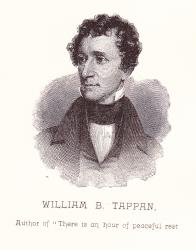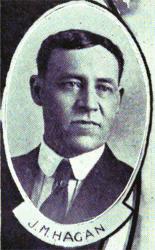Planning worship?
Check out our sister site, ZeteoSearch.org,
for 20+ additional resources related to your search.
- |
User Links
Search Results
There is a harp whose thrilling sound
Author: John C. F. Kyger Appears in 13 hymnals
There is a harp whose thrilling sound
THERE IS A HARP
Meter: 8.8.8.8 Appears in 1 hymnal Incipit: 51712 53421 75614 Used With Text: Hallelujah, hallelujah! Our Redeemer shall reign
THERE IS A HARP
[There is a harp whose thrilling sound]
Appears in 1 hymnal Composer and/or Arranger: J. M. Hagan Incipit: 13215 16532 22212 Used With Text: The Heavenly Harp
[There is a harp whose thrilling sound]
The Heavenly Harp
Author: John C. F. Kyger; J. M. Hagan Hymnal: Sacred Chimes #163 (1900) First Line: There is a harp whose thrilling sound Refrain First Line: Heav'nly harp whose thrilling sound Languages: English Tune Title: [There is a harp whose thrilling sound]
The Heavenly Harp
Heavenly harp whose thrilling sound
Author: John C. F. Kyger Hymnal: Happy Voices No. 1 #d153 (1898) First Line: There is a harp whose thrilling sound Languages: English
Heavenly harp whose thrilling sound
There is a harp whose thrilling sound
Hymnal: Plymouth Collection #a1222 (1863)
There is a harp whose thrilling sound
William B. Tappan

1794 - 1849 Author of "The Heavenly Harp" See also in:
Hymn Writers of the Church
=============================
Tappan, William Bingham, was born at Beverley, Massachusetts, Oct. 29, 1794, and was apprenticed to a clockmaker at Boston in 1810. In 1815 he removed to Philadelphia, where he was engaged in business for a time. In 1822 he was engaged as Superintendent of the American Sunday School Union. In 1840 he was licensed to preach with the Congregational body, his sphere of usefulness on behalf of Sunday Schools being thereby considerably widened. He died suddenly, of cholera, at West Needham, Massachusetts, June 18,1849. His poetical works include:— (1) New England and Other Poems, 1819; (2) Poems, 1822; (3) Lyrics, 1822; (4) Poetry of the Heart, 1845; (5) Sacred and Miscellaneous Poems, 1848; (6) Poetry of Life, 1848; (7) The Sunday School and Other Poems, 1848; (8) Late and Early Poems, 1849; (9) Sacred Poems, 1849; (10) Gems of Sacred Poetry, 1860.
Of these works the earliest are the most-important. His hymns in common use include the following:—
1. Holy be this as was the place. Public Worship. Included in his Lyrics, 1822; and given in Lyra Sacra Americana, 1868.
2. The ransomed spirit to her home. Love. Appeared in Nettleton's Village Hymns, 1824. This is probably his best hymn.
3. There is an hour of hallowed peace. Heaven, a Place of Rest. Given in his New England and Other Poems, 1819.
4. There is an hour of peaceful rest. Heaven a Place of Rest. The author's account of this hymn in his Gems of Sacred Poetry, 1860, is that it "was written by me, in Philadelphia, in the summer of 1818, for the Franklin Gazette, edited by Richard Bache, Esq., and was introduced by him to the public in terms sufficiently flattering to a young man who then certainly lacked confidence in himself. The piece was republished in England and on the Continent, in various newspapers and magazines, and was also extensively circulated in my own native land, where it has found a place in several hymn and music-books. It was published in my first volume of Poems, at Philadelphia, in 1819, and soon after was set to music by A. P. Heinrich, Esq., in the same city." It is in Lyra Sacra Americana, 1868, p. 265.
5. 'Tis midnight, and on Olive's brow. Gethsemane. Appeared in his Poems, 1822, and repeated in Lyra Sacra Americana, 1868, and several hymnals.
6. Wake, isles of the south, your redemption is near. Missions. Appeared in the Lyrics, 1822. It was sung at the wharf in New Haven at the embarkation of Missionaries for the Sandwich Islands, 1822.
7. When sorrow casts its shades around us. Resignation. From his New England and Other Poems, 1819. It is in Lyra Sacra Americana, 1868.
8. While the solemn note of time. Saturday Evening. Published in his Poems, 1822; repeated in Lyra Sacra Americana, 1868, and thence into Thring's Collection, 1882. [Rev F. M. Bird, M.A.]
--John Julian, Dictionary of Hymnology (1907)
William B. Tappan
J. M. Hagan

1858 - 1933 Author (Chorus) of "The Heavenly Harp" in Sacred Chimes DEACON JAMES MONROE HAGAN: Professor J. M. Hagan, as he was affectionately known, was born in Monroe County, Kentucky, on February 25, 1858, and was the son of James Fendel and Sarah Strode Hagan. He was reared under the most difficult circumstances but was able to work his way through the meager common schools, college and university. He followed the profession of teaching all of his life. His principal teaching was in High Schools in Warren, Munroe [sic], Metcalf [sic], Hart, and Daviess Counties, in Kentucky. He was head or joint head in Munroe [sic] Normal for many years located at Flippin, Kentucky; with Professor T. C. Gillianwaters. Altogether he taught for forty years.
Mr. Hagan married Miss Ella B. Evans of Tompkinsville, Kentucky, in 1892. One daughter, who died early in life, and one son, blessed this union. After the death of his first wife he married Miss Rubye Vance of Paducah, Kentucky, in 1907. Three sons, all of whom are now in the armed forces, blessed this second union.
He was an outstanding musician, receiving his musical training in Tompkinsville, Bowling Green Normal, Moody Bible Institute, and the Cincinnati College of Music. His first musical composition was written at the age of sixteen and over 800 of his hymns were published. He also edited two public school song books and was very active in putting music into the public schools. He taught countless numbers to sing and was associated with such authors as Bliss, Stebbins, Rodeheaver, Coleman, Showalter, Vaughn Brothers and others. For about five years he traveled with an outstanding male quartet.
He was converted at the age of fourteen and united with a Baptist Church. After holding membership in the Bowling Green and Owensboro First Churches for years he spent his last days in the Seven Hills Church where he served as Deacon, Sunday School Teacher, and Choir Director. He died in Owensboro, Kentucky, on January 25. 1933, and is buried here. This good man was Munroe [sic] County's greatest gift to the world.
from "A HISTORY OF THE DAVIESS-McLEAN BAPTIST ASSOCIATION IN KENTUCKY, 1844-1943" by Wendell H. Rone.
J. M. Hagan
John Charles Fremont Kyger
1860 - 1960 Person Name: John C. F. Kyger Author (vs. 2, 4) of "The Heavenly Harp" in Sacred Chimes
John Charles Fremont Kyger


 My Starred Hymns
My Starred Hymns

